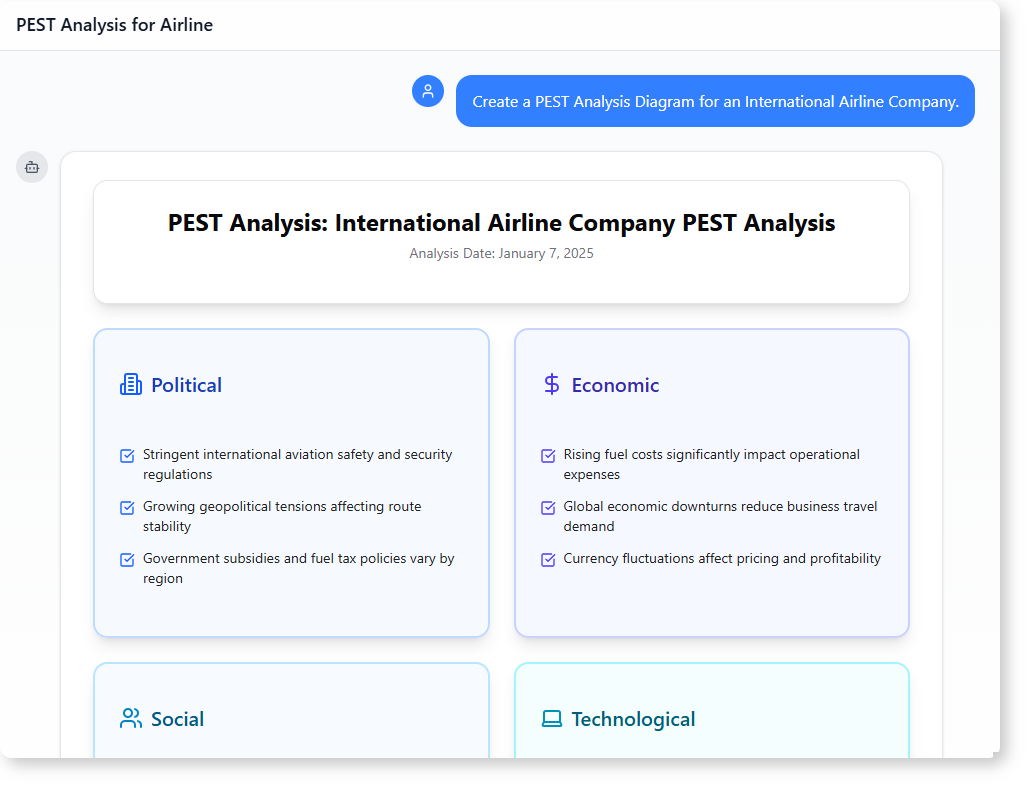Now Reading: How to Generate a PEST Analysis for an International Airline with AI-Powered Modeling Software
-
01
How to Generate a PEST Analysis for an International Airline with AI-Powered Modeling Software
How to Generate a PEST Analysis for an International Airline with AI-Powered Modeling Software
Why an International Airline Needs a PEST Analysis
Running a global airline is full of moving parts. From fuel prices to political tensions, the environment changes fast. A solid PEST Analysis—covering Political, Economic, Social, and Technological factors—helps decision-makers stay ahead.
That’s where AI-powered modeling software comes in. It doesn’t just generate diagrams. It creates clear, context-rich insights that match real-world challenges.
This guide walks through how a professional used AI-powered modeling software to build a PEST Analysis specifically for an international airline. No guesswork. No manual work. Just clear, actionable output.

The User’s Background and Objective
The user is a strategic operations manager at a mid-sized international airline. They were tasked with preparing a report for the executive team to support new route decisions.
Their main goal wasn’t just to list factors—like fuel costs or safety rules. They needed a structured, visual PEST Analysis that could be used in strategic planning. They also wanted to understand the deeper implications of each factor.
Traditionally, this would take hours of research and manual drafting. With AI-powered modeling software, the process is streamlined and insightful.
Step-by-Step Journey with the AI-Powered Modeling Software
The process began with a simple prompt:
‘Create a PEST Analysis Diagram for an International Airline Company.’
The AI responded by generating a clear, categorized diagram showing the four pillars: Political, Economic, Social, and Technological. Each category included specific, relevant factors tied to the airline’s operations.
Next, the user asked:
‘Generate a structured interpretation of the PEST Analysis for strategic planning.’
The AI didn’t just list points. It provided context. It explained how each factor affects the airline’s business, and how they interact. For example:
- Political instability in key regions means route planning must include contingency plans.
- Rising fuel costs directly pressure profit margins, especially in high-cost zones.
- Passenger demand for sustainable flights creates a business opportunity in green aviation.
- AI-driven scheduling improves operational efficiency but requires investment in training.
The output was not just a diagram. It was a thoughtful breakdown of risks, opportunities, and operational shifts. All tailored to the airline’s reality.
What the AI-Powered Modeling Software Delivers
Unlike generic tools, this AI-powered modeling software doesn’t just draw a PEST diagram. It helps you:
- Identify critical external forces affecting your business.
- Understand how these forces interact in real time.
- Translate them into strategic actions for planning.
The PEST Analysis generated includes:
| Factor | Key Insight |
|——–|————-|
| Political | Geopolitical tensions impact route stability; compliance with safety rules is non-negotiable. |
| Economic | Fuel costs and currency swings directly affect profitability and pricing strategies. |
| Social | Passengers now expect transparency about emissions and pricing. |
| Technological | Digital check-in and AI-driven scheduling improve service and reduce costs. |
This level of detail makes the analysis practical—not just theoretical.
Real-World Application in Strategic Planning
With this analysis, the airline leadership could now make informed choices:
- Consider rerouting flights in politically unstable zones.
- Re-evaluate fuel pricing models based on regional cost shifts.
- Launch a sustainable flight campaign to meet passenger expectations.
- Pilot AI-based scheduling in select hubs to improve efficiency.
The AI-powered modeling software turned a static diagram into a living tool for decision-making.
Frequently Asked Questions
How does AI-powered modeling software help with PEST Analysis?
It automates the structure and content of a PEST Analysis, focusing on relevant, real-world factors. Instead of relying on memory or scattered research, users get a clear, fact-based view tailored to their industry.
Can this tool be used for other industries?
Yes. The same AI-powered modeling software can generate PEST diagrams for sectors like logistics, retail, or healthcare—just by adjusting the prompt.
Is the output based on real data or assumptions?
The output reflects current trends and industry patterns. While not a full data report, it’s grounded in actual developments observed in the airline and global markets.
Why choose AI-powered modeling software over traditional methods?
Manual PEST Analysis takes time and effort. With AI-powered modeling software, you get accurate, timely insights without the need to manually compile or categorize information.
Ready to map out your system’s interactions? Give our AI-powered modeling software a try at Visual Paradigm’s AI Chatbot today!
